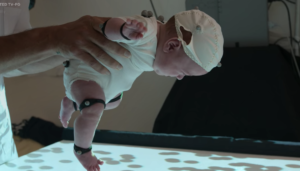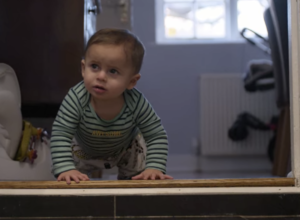
Summary:
The third episode, “Crawling,” begins with a narrator explaining how babies are “slaves to gravity” and remain where they are placed for their first few months until they learn to crawl and explore on their own. A mother from London describes her feelings about going back to work while her husband stays home with their son and is able to be there for all of his milestones. Her son also does not seem to want to crawl which concerns her.
Dr. Marianne Barbu-Roth, director of the Motor Development Group at the Universite of Paris in France, explains how it was thought for many years that crawling is only a transitional stage to walking. She shows how newborn babies can actually move, when on the mother’s stomach, to the mother’s breast after only one hour as well as crawling, or swimming, in water very soon after birth. She explains the basis of her experiment which gives babies the illusion that they are moving with black dots moving in the same direction on a white background. When the babies see the dots and are held above them, they begin to “swim in the air.” This behavior demonstrates a “primitive link” between vision and the brain and the motor system so the baby will move in response to something they see, proving crawling is not just a reflex. The researchers then created a “Crawlerskate,” a modified skateboard which allowed newborn babies around two days of age to move around without having to support their massive heads, and the babies were able to ‘crawl’ all over a mattress. Dr. Barbu-Roth proclaims that she thinks we are not born as bipeds, but quadrupeds, because we move both our arms and legs while walking, so crawling is not a transitory stage.
In Atlanta, Dr. Michelle Lampl, a professor at the Emory Center for the Study of Human Health, details her experiences of measuring the length of a baby over two days, with measurements that varied by two centimeters. She uses a growth chart to demonstrate how we think that babies’ growth is continuous every day, but it is not a gradual process. Dr. Lampl measured thirty babies daily and found that babies grew between 0.5 and 1.65cm in one day, between two to twenty-eight days of no growth. These growth spurts changed their sleeping patterns, inciting tantrums as well as insatiable hunger. Therefore, growth does not happen in a curve, but in jumps separated by time. Dr. Lampl describes how she was hostilely interrogated by a leading figure in the field when she presented her data as the person found it hard to believe.
In New York City, Dr. Karen Adolph, a psychology professor at NYU, details how human mobility is not always on a flat surface, so babies are required to use perception to guide their movements. Dr. Adolph built an “adjustable slope apparatus” where babies crawl down a slope that increases in steepness by six degrees at a time, having a successful trial if they crawl down without touching their stomach. The novice crawler babies approach a 90-degree drop-off in the same way as a shallower slope, indicating that they do not yet know how to distinguish what they can do. Intermediate crawlers are better able to perceive what they can and cannot do and stop at the edge, while advanced crawlers switch between crawling on hands and knees as well as using their feet. Advanced crawlers, with roughly twenty weeks of crawling experience, are better able at finding alternative strategies to crawl safely, like going backward down the slope. She also describes how babies start to crawl, and how they start by only doing it on some days with days in between with no crawling activity. There is no steady progression from one stage to another and babies acquire their skills in different orders, including the baby from the beginning of the episode who seemed to skip crawling and went straight to standing and walking. Dr. Adolph ends the episode by saying “crawling isn’t mandatory” as babies all develop in their own way.

Review:
As we can see, crawling is not entirely critical to human development, and sometimes babies decide to start walking without including the assumed transitional step. This phenomenon is also seen in the Ache people in Paraguay, where the babies are carried until they are able to walk with no crawling (Kuther, 2020). In her autobiography and memoir on her medical practice, Clio in the Clinic: History in Medical Practice, Dr. Jacalyn Duffin describes her research and experience with babies. She uses evidence from multiple studies to show that we may have recently changed our babies’ developmental trajectory by placing them on their backs in order to prevent SIDS (Duffin, 155). In a study started in England in 1990, it was discovered “as parents uniformly began putting babies on their backs, more and more babies did not roll over or crawl on schedule, and increasing numbers never crawled” (Duffin 155). Therefore, babies are not required to crawl to walk and public health measures can affect how babies start to move.
